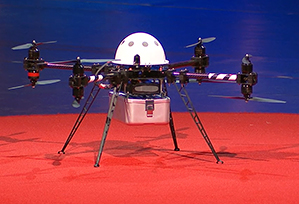Separating Hype from Reality on Amazon’s Drones
Amazon’s plans to deliver packages by drones, which it predicts “will be as normal as seeing mail trucks on the road today,” has been widely dismissed as little more than clever self-promotion.

Yet, in some contexts, drone delivery has shown potential. Last year, a startup called Matternet in Palo Alto, California, tested drones as a way to deliver supplies to refugee camps in Haiti and found it cost only 20 to 70 cents to deliver a two-kilogram package 10 kilometers—at least a fivefold savings compared to standard truck delivery.
“Technically it is totally feasible,” says R. John Hansman, a professor of aeronautics at MIT. “The key issues will be if the [Federal Aviation Administration] allows this kind of operation—they should—and if the business case makes sense.”
But Hansman says the delivery cost could be steep: “They will have to charge a significant premium for this kind of delivery, so the products would need to be worth a $100 to $200 delivery fee for a five-pound or so package.”
For home delivery to work safely and ubiquitously, it would mean avoiding every power line on a suburban street, deciphering satellite maps to decide what precise spot on a property to land, and making sure a drone didn’t hit an errant child or dog. Hansman called those challenges “not insurmountable.”
Even if those challenges were dealt with, in the United States, drone use by Amazon would likely be a niche, high-cost service for high-value items. The FAA is currently working on drone safety and usage rules that are supposed to take effect in 2015. The rules are expected to lead to new commercial uses, including building inspections, police work, and delivery services (see “Flying Robots”).
Matternet launched from Singularity University with $500,000 in seed funding, along with a second drone-delivery startup, Aria Logistics, which aims to build an autonomous logistics infrastructure. Matternet envisions delivering packages to predetermined “pads”— rather than dropping them on the front walkway to a house, as was depicted in an Amazon demonstration video.
Amazon revealed the plan in an interview with the company’s founder, Jeff Bezos, that aired on 60 Minutes on Sunday night—during which Bezos acknowledged the challenge. “The hard part here is putting in all the redundancy, all the reliability, all the systems you need to say, ‘Look, this thing can’t land on somebody’s head while they’re walking around their neighborhood,’ ” he said.
But in an online Q&A, Amazon expressed confidence in the technology and said it would be ready as early as 2015—and even offered a 30-minute delivery promise for packages of up to five pounds, if the regulations allowed it.
“There is a lot of hype around what Amazon has said yesterday, but we shouldn’t be fooling ourselves,” says Andreas Raptopoulos, CEO of Matternet. “The technology is not all there yet to allow us to do it, and the regulations are not there yet to allow us to do it. We are talking about all different weather conditions, over very difficult terrain and winds. It requires quite a bit of testing to execute on those things.”
Amazon did not respond to questions about how it would try to overcome those problems. Amazon proposes using a so-called octocopter, which has eight spinning rotor blades and can continue flying if one of them fails. Matternet also used an eight-rotor drone for its trial. Both are versions of commercially available drones.
Already, Canada and Australia have regulations that allow some commercial drone use, says Raptopoulous. And testing has begun in some parts of the world. In Sydney, Australia, a textbook seller called Zookal says it plans to use six drones to drop off books at outdoor locations. And a Chinese company, Shunfeng Express, is testing package delivery in Dongguan, China.
The Matternet vision includes a network of hubs where drones could recharge for longer-range flights, and provide services like medicine or farm-supplies to be delivered to people in remote parts of developing countries. “We call it a network for matter, which could have tremendous impacts for people here and in the developing world where there are no roads,” Raptopoulos said.
Keep Reading
Most Popular
Large language models can do jaw-dropping things. But nobody knows exactly why.
And that's a problem. Figuring it out is one of the biggest scientific puzzles of our time and a crucial step towards controlling more powerful future models.
How scientists traced a mysterious covid case back to six toilets
When wastewater surveillance turns into a hunt for a single infected individual, the ethics get tricky.
The problem with plug-in hybrids? Their drivers.
Plug-in hybrids are often sold as a transition to EVs, but new data from Europe shows we’re still underestimating the emissions they produce.
Google DeepMind’s new generative model makes Super Mario–like games from scratch
Genie learns how to control games by watching hours and hours of video. It could help train next-gen robots too.
Stay connected
Get the latest updates from
MIT Technology Review
Discover special offers, top stories, upcoming events, and more.